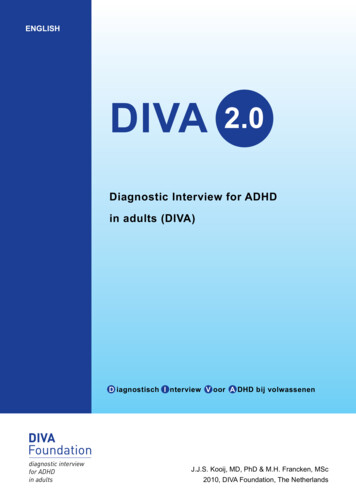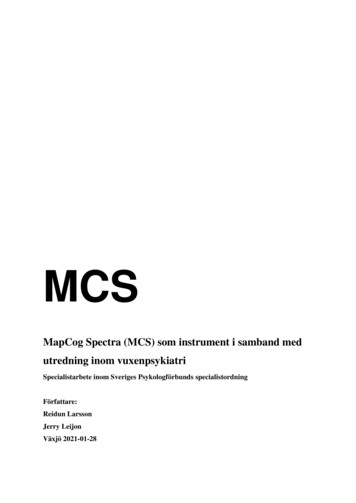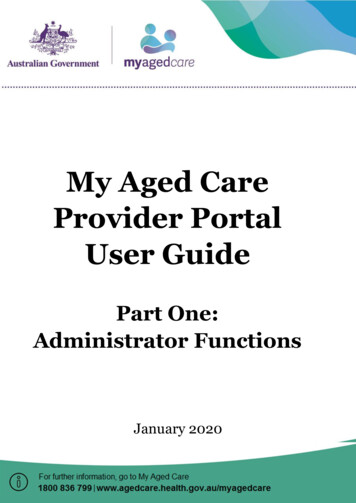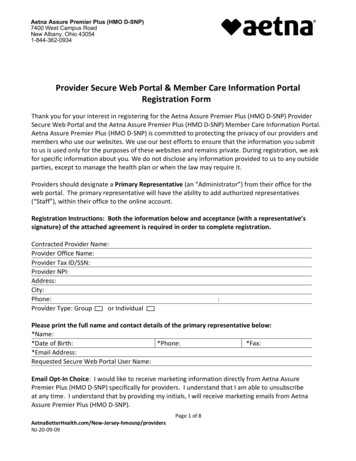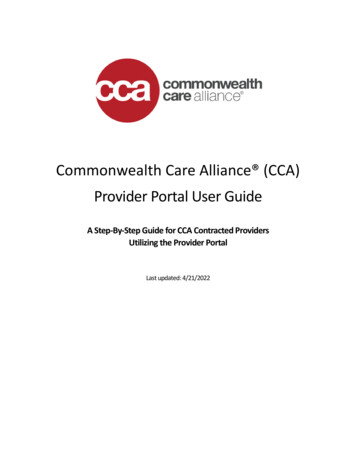
Transcription
Stay activeFactors motivating elderly people to stay physically active after physiotherapyAhmed El ShafeyPhysiotherapy, master's level (120 credits)2019Luleå University of TechnologyDepartment of Health Sciences
Luleå tekniska universitetInstitutionen för hälsovetenskapAvdelningen för hälsa och rehabiliteringStay active.Factors motivating elderly people to stay physically active after physiotherapyFortsätt vara aktiv.Faktorer som motiverar äldre personer att fortsätta vara fysiskt aktiva efter fysioterapiAuthor: Ahmed El ShafeyMaster thesis in physiotherapy, 15 hpS7038H/Spring semester 2019Supervisor: Guvor GardExaminer: Lars Nyberg1
ABSTRACTBackground: Despite the known benefits of physical activities in the management of manychronic diseases associated with aging, a majority of elderly patients within primary health carehave difficulties reach the daily recommendation of physical activity and risking being inactiveafter physiotherapy. Therefore, it is important to understand the factors influencing theirmotivation in order to provide support for them to stay physically active after physiotherapy.Aim: To describe the perceived latent motivating factors to stay physically active afterphysiotherapy among elderly people.Method: The Data was collected by open-ended interviews conducted with ten Swedish patientsaged 69-88 years and then analyzed using content analysis and interpreted within a socialcognitive theory framework context.Results: The results contributed to one theme “Ability to cope with one-self, others and theenvironment“ combined with three categories. The categories were subjective factors, physicalactivity-related factors, and environmental factors. The result supports the participants’characteristics that were partially similar to those in older age population. However, the currentstudy contributed with new knowledge within each category. The outcome of these factors hasshown that all participants enjoy high self-efficacy despite the variation in their healthconditions. Inner feelings such self-blaming, discouragement and fear of being left out andalone expressed as matter of high relevance to older adults’ motivation, but not often consideredwithin physiotherapy. The results also showed that having others as role models was not asimportant as having professional support. Additionally, relevant information, type of sportfacilities and physical activities as well as having fixed routines for physical activitiesinfluenced their motivation.Conclusion: The ability to cope with one-self, others and the environment was the mainmotivating factor to stay physically active after physiotherapy. This coping ability wasinfluenced by subjective factors, physical activity-related factors and environmental factors.Health care professionals should be aware of these motivating factors and use them as a guideto support elderly patients’ motivation to stay physically active.Keywords: Physical activity, older people, motivation, physical therapy.2
SAMMANFATTNINGBakgrund: Trots de välkända fördelarna med fysiska aktiviteter i hanteringen av mångakroniska sjukdomar i samband med åldrandet har en majoritet av äldre patienter inomprimärvården svårigheter att nå de dagliga rekommendationerna av fysisk aktivitet och riskeraratt bli inaktiva efter fysioterapi. Därför det är viktigt att förstå de faktorer som påverkar derasmotivation för att hjälpa dem att fortsätta vara fysiskt aktiva efter fysioterapi.Syfte: Att beskriva de upplevda latenta motivationsfaktorerna för att fortsätta vara fysisk aktivefter fysioterapi bland äldre människor.Metod: Studiens data samlades in genom halv-strukturerade intervjuer med svenska patienter iåldern 69-88 år och analyserades sedan med hjälp av innehållsanalys och tolkades inom ramenför social kognitiv teori.Resultaten bidrog till ett tema "Förmåga att klara sig själv, andra och miljön" tillsammans medtre kategorier. Kategorierna var subjektiva faktorer, fysikaliska aktivitetsrelaterade faktorer ochmiljöfaktorer. Dess resultateten stöder deltagarnas egenskaper som liknade dem i äldreåldersbefolkning. Den nuvarande studien bidrog emellertid med ny kunskap inom varjekategori. Resultaten av dessa faktorer har visat att alla deltagare har hög self-efficacy trotsvariationen i deras hälsotillstånd. Inre känslor som självskyllande, modlöshet och rädsla för attbli utelämnad och ensam som uttryckt av hög relevans för äldre vuxnas motivation, men inteofta betraktas inom fysioterapi. Resultaten visade också att se andra som rollmodeller inte varlika viktigt som att ha professionellt stöd. Dessutom har relevant information, typ avsportanläggningar och fysiska aktiviteter samt fasta rutiner för fysiska aktiviteter påverkat derasmotivation.Slutsats: Förmågan att klara sig själv, andra och miljön var den främsta motivationsfaktorn attfortsätta vara fysiskt aktiv efter fysioterapi. Denna coping förmåga påverkades av subjektivafaktorer, fysiska aktivitetsrelaterade faktorer och miljöfaktorer. Hälso- och sjukvårdspersonalbör vara medvetna om dessa motivationsfaktorer och använda dem som en vägledning för attstödja äldre patienters motivation att vara fysiskt aktiv.Nyckelord: Fysisk aktivitet, äldre personer, motivation, fysioterapi.3
INDEXINTRODUCTION .5BACKGROUND .6METHOD .9Study Design .9Selection of Informants . 10Procedure . 10Participants. 11Data Collection. 11Pilot interview . 11Interviews and procedure . 11Data analysis . 12Ethical aspects . 13RESULTS . 13To copy with one-self, other and environment . 14Subjective factors . 15Physical activity-related factors . 16Environmental factors . 17DISCUSSION . 18Method discussion . 18Result discussion . 20Implications for physiotherapists and other healthcare professionals . 23CONCLUSION . 24REFERENSLISTA . 24APPENDICES . 294
INTRODUCTIONAccording to the (World Health Organization [WHO], 2018) physical activity has,physiological, mental, social and cultural benefits for individuals of all ages. There are groupsof people with specific needs where distinctive efforts are required such as elderly populationwho are increasing like no other age group in the whole world (WHO, 2018). As aphysiotherapist who works mainly with older people I should assess their functions andstructures, and also to encourage them to discuss their emotions, experiences and believes(Skjaerven, Kristoffersen & Gard, 2009; Wikström & Eriksson, 2012). This drives me tobalance between what they need to do in relation to what they are capable to do. It appeared tome that older people 65 years old and above do not reach the international recommendation ofphysical activities and was risking being physically inactive. The reasons to their inactivityappeared to be multifactorial, most importantly their low motivation which also is identified inprevious research (De Souto Barreto, Rolland, Vellas, & Maltais, 2019; Leijon, Faskunger,Bendtsen, Festin, & Nilsen, 2011; Stødle, Debesay, Pajalic, Lid, & Bergland, 2019)). Thereforewe - physiotherapists in specific and health care professionals in general- should increase ourunderstanding of the motivating factors perceived as important by elderly people to be able tosupport them to stay physically active in order to overcome this inactivity and promote theirphysical health and quality of life.5
BACKGROUNDPhysical activity among elderlyPhysical activity can be defined as any bodily movement produced by skeletal muscles thatrequire energy expenditure which can include recreational activities such as sports, physicalexercise and gardening, activity at work or home, as well as active motion such as walking andcycling (Dasso, 2019 ; Frändin & Helbostad 2015; WHO, 2018). Exercise on the other hand isa planned physical activity that, structured, repetitive, and purposive and aim to improve ormaintain one or more components of physical fitness (Dasso, 2019). In the current study theterm physical activity will be used throughout the study. Regular physical activities decreasethe risk of a number of age-related diseases such as cardiovascular disease (Soares, Siscovick,Psaty, Longstreth, Mozaffarian, 2016), type 2 diabetes, obesity and cancer (Sun, Norman,White, 2013; Chodzko-Zajko et al., 2009). Physical exercise has also boosting effect onfunction in a number of chronic diseases such as chronic obstructive pulmonary disease(COPD), depression, heart failure, osteoporosis, osteoarthritis, stroke, chronic back pain andconstipation (Musich, Wang, Hawkins, & Greame, 2017 ; Sun et al., 2013; Chodzko-Zajko etal., 2009). Evidence has also shown that physical exercise is advantageous for cognitivefunction for elderly (Carvalho et al., 2014; Langhammer, Bergland & Rydwik, 2018;Prakash,Voss, Erickson, Kramer, 2015) A systematic review by Carvalho et al. (2014) reported that 26studies had shown a positive correlation between physical exercise and the maintenance orimprovement of cognition. Musich et al,. (2017) found that it is desirable to encourageintermediate and high intensities of physical activity for elderly.Elderly people’s complex health problems and obstaclesThe elderly population in the Nordic countries can be defined as being above 65 years (Frändin& Helbostad 2015), which is also a common retirement age (Karp, Agahi, Lennartsson,Lagergren and Wånell (2013) therefore I will use this definition when referring to elderly peoplein this current study. According to WHO (2018) the number of elderly people will reach 1.2billion by 2025 and the life expectancy in Sweden by 2070 will be over 89 years for womenand over 87 years for men. This means that there will be an increase of five years for womenand by just over six years for men from what it is now (SCB, 2018).Older age is characterized by progressing of several complex health conditions that developslater in life and which do not fall into distinct disease categories (WHO, 2018). These are6
commonly called geriatric syndromes which are frequently described as the consequence ofseveral causal factors such as urinary incontinence, fatigue, depression, falls, and delirium(Clegg, Young, Iliffe, Rikkert & Rockwood (2013). These geriatric syndromes may act as betterpredictors of death than the presence or number of specific diseases (WHO, 2018). On the otherhand the term frailty often used within geriatric science and refers to a biologic syndrome ofreduced reserve and resistance to stressors, related to cumulative declines across multiplephysiologic systems and implying a high risk for falls, disability, hospitalization, and mortalityand (Clegg, Young, Iliffe, Rikkert & Rockwood (2013).In addition of the complex health condition elderly people often struggle to complete plannedtreatment, such as exercising, both during an ongoing physiotherapy intervention after(Robinson, Newton, Jones, & Dawson, 2014; Leijon, Faskunger, Bendtsen, Festin, & Nilsen,2011; Forkan et al., 2006). Some factors for non-compliance such as disease / pain duringexercise and low motivation were Identified (Forkan et al., 2006; Leijon, Faskunger, Bendtsen,Festin, & Nilsen, 2011; Aartolahti, Tolppanen, Lonnroos, Hartikainen, & Hakkinen, 2015).Other common reasons for non-compliance are perceived lack of effect of the training, lack oftime and lack of training due to the weather or lack of interest in exercise (Forkan et al., 2006;Leijon, et al., 2011; Aartolahti et al., 2015). Furthermore, studies show that reduced complianceis seen for example in persons with impaired cognitive ability, depression, poor health status,high age and low education level (Leijon et at., 2011; Aartolahti et al; 2015). Research hasalso shown that health literacy is lower in people 65 years (Serper et al., 2014). Good healthliteracy provides participants with better conditions for increased participation in treatmentsand contributes to an increased knowledge of their health condition and increased self-efficacy.This increases their ability to take power over their own situation and treatment (empowerment)and to overcome obstacles and improve compliance to physical activity (Abel & Sommerhalder,2015; WHO, 2009). This together may lead to better health, reduced healthcare consumptionand healthcare costs (Briggs & Jordan, 2010).Motivation to physical activityMotivation can be defined by Goudas, Biddle and Fox (2011) as an ongoing process of workwith one owns abilities, wishes and goals. By Deci and Ryan (2000) motivation was describedas a mood, a desire and joy to do something. Deci and Ryan split motivation into two parts;internal and external motivation. Inner motivation means that an activity is performed for one'sown sake compared to external motivation that means that an activity is performed to get an7
external reward or avoid a punishment. All individuals are affected by an interaction betweensuch internal and external factors (Deci & Ryan, 2000). There are different influences onmotivation to physical active, which can be both negative and positive influences and also canbe personal or social environmental related (Biedenweg et al., 2013). Previous studies foundthat self-help strategies that were used to maintain independence in daily tasks despite adversesituations and being resourceful might improve adaptive functioning and coping skills led to ahealthy life (Franke et al., 2013). Resnick, (2002) described that when one believed in theefficacy of a specific activity one became more motivated to perform that activity.The social environment or social conditions in which people live and work have a prominentinfluence on health. In addition, the social environment influences elderly people s physicalactivity levels (Hanson, Ashe, McKay, & Winters, 2012). Day (2008) found that walking toand visiting public locations allowed them to feel a part of a broader community orneighborhood. Being physically active enhanced the opportunities for social interactions andvice versa. That is, engaging in social activities promotes physical activities (Salvador, Reis, &Florindo, 2010). Environmental factors such as availability of sidewalks, pleasant scenery andthe presence of neighborhood footpaths strongly correlate with increased walking and physicalactivities among elderly (Franke et al., 2013).Social Cognitive TheorySocial Cognitive Theory (SCT) has been one of the most applied theoretical models tounderstand the physical behavior of older people (McAuley & Blissmer, 2000). Bandura,(2004) specified a basic set of psychosocial determinants to effectively understand a wide rangeof health problems, including physical activity within the SCT. Self-efficacy reflects one’sbeliefs in one’s abilities to effectively complete a progression of achievement and has generallybeen shown to be the “active agent” in SCT models (Bandura, 2004). The same author specifiedthe pathways through which social cognitive constructs affect physical activity behavior. Inparticular, self-efficacy works both directly and indirectly, through factors such as performance,expectations, and goals to facilitate behaviors. These factors suggest that persons with higherlevels of self-efficacy have more positive expectations of what behavior will benefit them,clearer goals for themselves and are more likely to overcome obstacles which will lead toengaging and retaining of specific behaviors (Bandura, 2004).8
Motivation to the studyPhysical therapy includes knowledge of the human being as a physical, mental, social andexistential in a health perspective and it aims to promote health, reduce symptoms, and maintainor regain optimal functions and movement abilities. This is especially true when older persons’function, activity and participation is limited or warns to be limited by for example, aging orphysical, psychosocial and/or environmental factors (Broberg, & Lenné, 2017). Primary carerehabilitation where I work is the first instance where most patients seek help(Fysioterapeuterna, 2018) and I meet a lot of elderly patients who have complex healthproblems and often struggle to adhere to physical activities as they age. This in return affectingtheir physical activity level and leaves the majority of them inactive. I found that (SCT) mayprovide a useful framework for understanding physical activity behavior of older people andfor developing and planning programs that target the start and preservation of physical activityin this population. Furthermore, in order be able to promote older people’s health and wellbeing to stay physically active and improve their quality of life and to formulate more effectiveinterventions and programs, it is important to understand their self-efficacy and abilities incombination with other motivators (Bandura, 2004). This type of understanding is consideredto provide new knowledge for us physiotherapist specially and health care professionalsgenerally especially most of the studies that have investigated motivation in relation to physicalactivities among elderly have used surveys which lack standardization (Troiano et al., 2012;Van Poppel et al., 2010), or recruited specific older people groups in their studies (Franke etal., 2013; Mathews et al, 2010; Resnick, 2002;).Aim of the studyTo describe elderly people s perception of motivational factors to stay physically active afterphysiotherapy.METHODStudy DesignA qualitative inductive approach was used to describe the latent motivating factors to stayphysically active after physiotherapy among elderly people. According to Holloway & Wheeler(2010) a qualitative approach can be used when the researcher wants to describe the participantsown experiences and perceptions. To get a deeper understanding about the perceptions ofelderly concerning motivating factors to stay physical active after physiotherapy the author used9
qualitative data analysis in form of open-ended interviews which according to (Carpenter &Suto 2008; Holloway & Wheeler, 2010) are the most common data collection method forqualitative research, and the interviews were then analyzed using content analysis (Graneheimet. al., (2017). Additionally, the interpretation of the core of the results were influenced by thesocial cognitive framework, specifically reciprocal determinism, which contributed toincreasing understanding of motivation and behavior in addition to the linear approachproposed by the concept of self-efficacy (Bandura, 2004).Selection of InformantsThe selection of informants was a purpose-oriented selection or criteria-related which meantthat I selected the informants in this study based on a number of pre-selected criteria, thisselection is frequently used with this type of qualitative research (Holloway & Wheeler, 2010;Patton 2015)The inclusion criteria for participating in this study were that the participants would be:Swedish-speaking elderly persons, 65 years or older, who had received a clinical physiotherapyintervention, and were recommended to stay physically active. All participants had previouscontact with one of three clinics within Rehab City in Stockholm where the author of the currentstudy worked and had excluded my patients.ProcedureThe recruitment was performed with the help of colleagues at all these three clinics. Potentialparticipants who met the criteria received verbal information about the study from his/herphysiotherapist. All patients who had been informed and were interested to participate got aninformation sheet (appendix 1) in Swedish about the study to read at home. Then eachparticipant made an active decision to participate by contacting the author in person, phone oremail and the participants then got more information about the study from the author andanswers to potential questions. To ensure enough participants the author additionally informedphysiotherapists on meeting at the workplace where all three clinics were presented andinformed about the study. They also got the information sheet and interview guide so they couldanswer questions from their patients.10
ParticipantsThe participants were ten in total, three men and seven women. Their ages varied from 69 to88 years. Their marital status varied also; 3 married, 7 widowed and 1 divorced. The majoritywere widowed and lived alone and 3 with spouses. Almost all had grown-up children whosupported them to stay physically active. Five of the participants have both children andgrandchildren who supported them, while 3 received support from spouses. Only oneparticipant did not receive this kind of support (Table 1).Table 1. Baseline information about the participantsnicknameKarlAnnaIngerAge69 y76 y88 yGenderMaleFemaleFemaletime in min35 min50 min40 minMarital statusMarriedDivorcedWidowedBrittDavid84 y82 yFemalemale37 min31 minWidowedWidowedMona78 yFemale40 minWidowedBodil88 yFemale22 minWidowedHannaHenrik77 y76 yFemaleMale31 min31 minMarriedWidowedSara77 yFemale33 minMarriedFamily supportwifeNoneChildren & grandchildrenChildrenChildren & grandchildrenChildren &grandchildrenChildren &grandchildrenChildrenChildren &grandchildrenChildrenData CollectionPilot interviewI performed a pilot interview before the start of the study to examine if the interview guide wasaccurately designed and if the questions in the interview guide, the participation letter and theconsent form were applicable and understandable for the informants. Some modifications wereperformed in the information letter (appendix 1) and in the interview guide (appendix 2) afterthe 70 minutes pilot interview.Interviews and procedureEach participant was interviewed only once and individually, in a place decided by theparticipant, through the use of open-ended face to face interviews according to the interviewguide. The interviews were conducted in Swedish and varied in length from 22 to 50 minutes,11
with an average of 35 minutes. All participants had the opportunity to describe their experiencesfreely. The questions in the interview guide are described in Appendix 2.Data analysisThe interviews were data recorded with a mobile phone, transcribed and then analyzed inSwedish with qualitative content analysis by me and support of my supervisor. Themethodological approach I used was inductive which means that I aimed to find new patternsand contexts within the chosen research area, such method recommended by Polit & Beck(2012). Content analysis means that I interpreted texts in the interviews by identifyingdifferences and similarities in the data material, this analysis recommended by Graneheim andLundman (2017). The analytical method in my study distinguished between a manifest and alatent content in a text where the manifest content was the visible content that emerges in a textand the latent content which I used described the interpreted content and the deeper meaning ofthe text. In order to find out the latent content. I analyzed the interviews according to Graneheimand Lundman (2017), which means that I read the interviews several times to get a completepicture of the material and started to identify meaning units which were (words or sentences)that together form a common context. When these were compiled, the next step in the analysiswas to condense them. That was, concentrating the meaning units into a common and centraldescription of these contexts. The contexts were then coded. The codes briefly described thecontent of the meaning units. After that suitable category that consisted of several codes thathad a similar content were established. That led to establishing of few categories that containeddifferent independent factors. During the whole analysis process I strive to interpret the contentof the data. At the end a theme, which was the meaningful “core” and the basic topic that ranthrough the data was set. Table 2 gives an example of the analyses procedure.Table 2. Example of analysis procedureMeaning unitYes, but it is clear , if you have to be physically active you have tobe active yourself, so to speak to find out what is available, noone will come and tell me what is there, but I will find out formyself.Condensation To be physically active you should be active yourself to find outwhat is available, I have to find out for myselfCodingTo be active yourselfSubcategoryKnowledge of relevant physical activitiesCategoryIndividual physical activity-related factorsThemeAbility to cope with self, others and the surroundings12
Ethical aspectsAll study participants received verbal and written information about the purpose of the study,that participation was voluntary and that they could end their participation at any time withoutspecifying why (Kvale & Brinkmann, 2017). All participants decided independently if theywanted to participate or not by taking contact with the author. If a participant decided toparticipate he/ she could contact the author by telephone, email or personally at the clinic anda date / place for the interview as well as an opportunity to get answers to any questions wereset. The interviews took place at a non-disturbing place. Before the interview, the authorsummarized the purpose of the study, emphasized that participation was voluntary, and wouldnot affect the participant's treatment at the respective clinic. The author repeated that theinterview would be recorded with a mobile phone and that no personal identificationinformation was needed. To obtain informed consent is an important ethical aspect of a study(Holloway & Wheeler, 2010). All participants gave their written consent to participate in thestudy. These forms were collected by the author before each interview and saved in lockprotected desk, which only the author had the key to. The study was approved by the EthicsGroup at the Department of Health Sciences. Luleå University of Technology on 7th of March2019.The interviews were recorded in Swedish using the interviewer's mobile phone. This mobilephone has a personal code and fingerprint lock and no other people had knowledge about thispersonal code. The recorded materials after each interview were transferred from the mobilephone to be stored in a password-protected computer together with the transcripts. All studymaterials were handled and stored safely according to recommendations by Holloway &Wheeler (2010). All participants could feel safe to participate in the study and freely share theirexperiences at the interview. Before the interview a version of consent form was signed by eachparticipate (appendix 3), those forms were stored in locked office desk. All the study materialswere only used by
influenced by subjective factors, physical activity-related factors and environmental factors. Health care professionals should be aware of these motivating factors and use them as a guide to support elderly patients' motivation to stay physically active. Keywords: Physical activity, older people, motivation, physical therapy.

